

The Rise of Padel Courts with Grass Surfaces
In recent years, the sport of padel has witnessed an explosive growth in popularity, not just in Europe but across the globe. With its combination of tennis, squash, and a dash of flair, padel attracts players of all ages and skill levels. One of the significant developments enhancing the padel experience is the growing trend of grass padel courts. This article explores the benefits and features of grass surfaces in padel, demonstrating why they are becoming increasingly popular among players and clubs alike.
The Unique Appeal of Grass Padel Courts
Grass courts have always been synonymous with elegance and tradition, especially in the world of tennis. However, when it comes to padel, the grass surface offers its own unique charm. One of the most noticeable advantages of grass courts is the softer playing surface, which is easier on the joints compared to hard court surfaces. This makes it an appealing option for players concerned about injury prevention, particularly older players or those new to the sport.
Moreover, grass courts provide a distinct playing experience. The ball behaves differently on grass; it typically travels slower and has a slightly lower bounce, which encourages longer rallies and strategic gameplay. This can lead to a more enjoyable session for players as they develop their skills in adapting to the varying conditions. The gentle natural surface also absorbs some impact, making for a more comfortable experience during extended matches.
Aesthetic and Environmental Benefits
Aside from the playing experience, grass courts offer aesthetic advantages. A well-maintained grass padel court can create picturesque settings that enhance the overall atmosphere of the venue. This aesthetic appeal can elevate the experience for spectators and players alike and can be particularly beneficial for clubs looking to attract new members or host tournaments.

From an environmental perspective, grass surfaces can also be more sustainable compared to synthetic materials. Natural grass can contribute to improved air quality and provides an excellent drainage system, reducing water runoff and erosion. When managed correctly, grass courts can have a smaller ecological footprint, aligning with a growing trend toward sustainability in sports.
Maintenance and Investment
However, it's crucial to acknowledge the maintenance that grass courts require. Regular mowing, watering, and fertilization are essential to ensure that the court remains in optimal playing condition. This heightened level of care can translate into higher maintenance costs for clubs. Nevertheless, many view this as a worthwhile investment, especially given the increasing interest in padel and the premium experience that a grass court can provide.
Conclusion
As the sport of padel continues to grow, the emergence of grass courts as a popular alternative to traditional surfaces is noteworthy. The combination of a player-friendly surface, aesthetic appeal, and potential environmental benefits makes grass padel courts an enticing option. As clubs and players embrace this evolution, one thing is clear grass padel courts are not just a trend but a significant advancement in enriching the playing experience and enhancing the vibrant culture surrounding the sport.
By further promoting the use of grass surfaces, the padel community can continue to cultivate a diverse range of playing conditions, allowing for creativity and skill development. As more players experience the joys of padel on grass courts, the future of this dynamic sport appears even brighter.
Durable Industrial Flooring Solutions for Factories Expert Installation
Premium Rubber Floor Mats Durable & Slip-Resistant Protection
Rubber Brick Non-Slip & Eco-Friendly Flooring Solutions
Premium Rubber Floor Mats Durable & Non-Slip Protection
Durable Rubber Floor Mats Slip-Resistant & Heavy-Duty
Industrial Flooring for Racquetball & Squash Facilities Durable, Safe Solutions